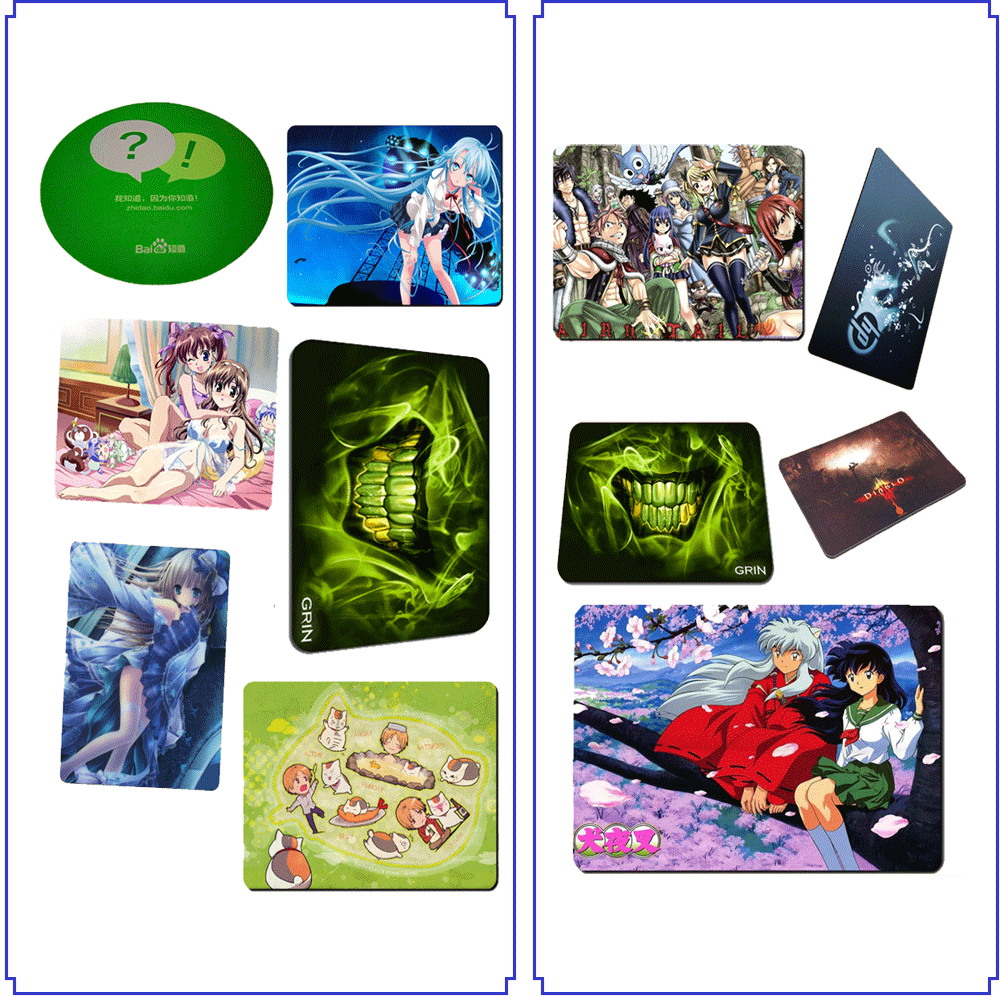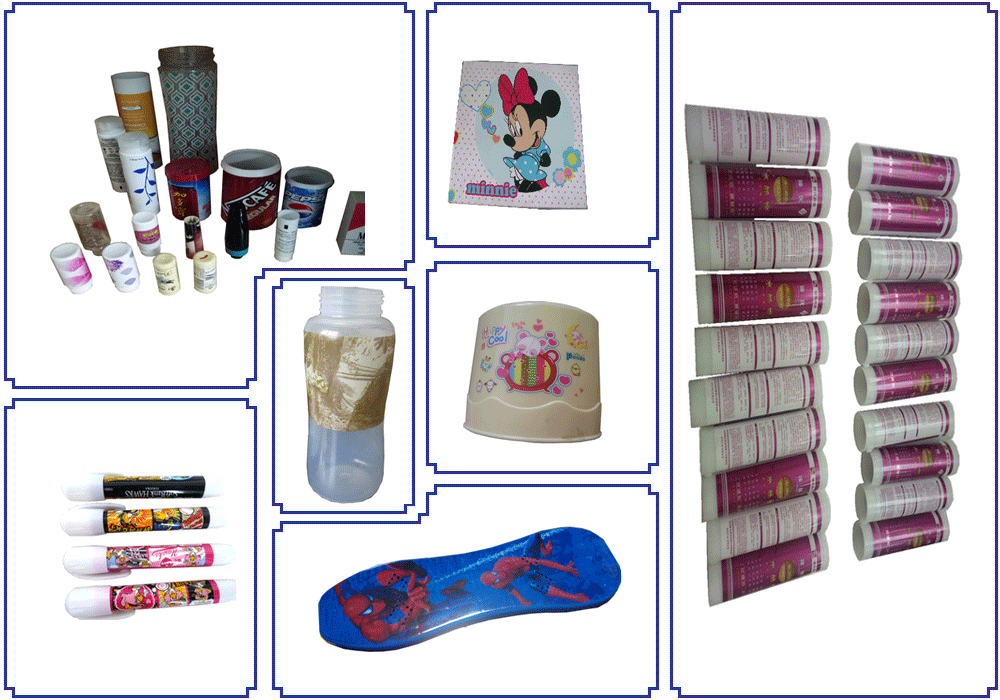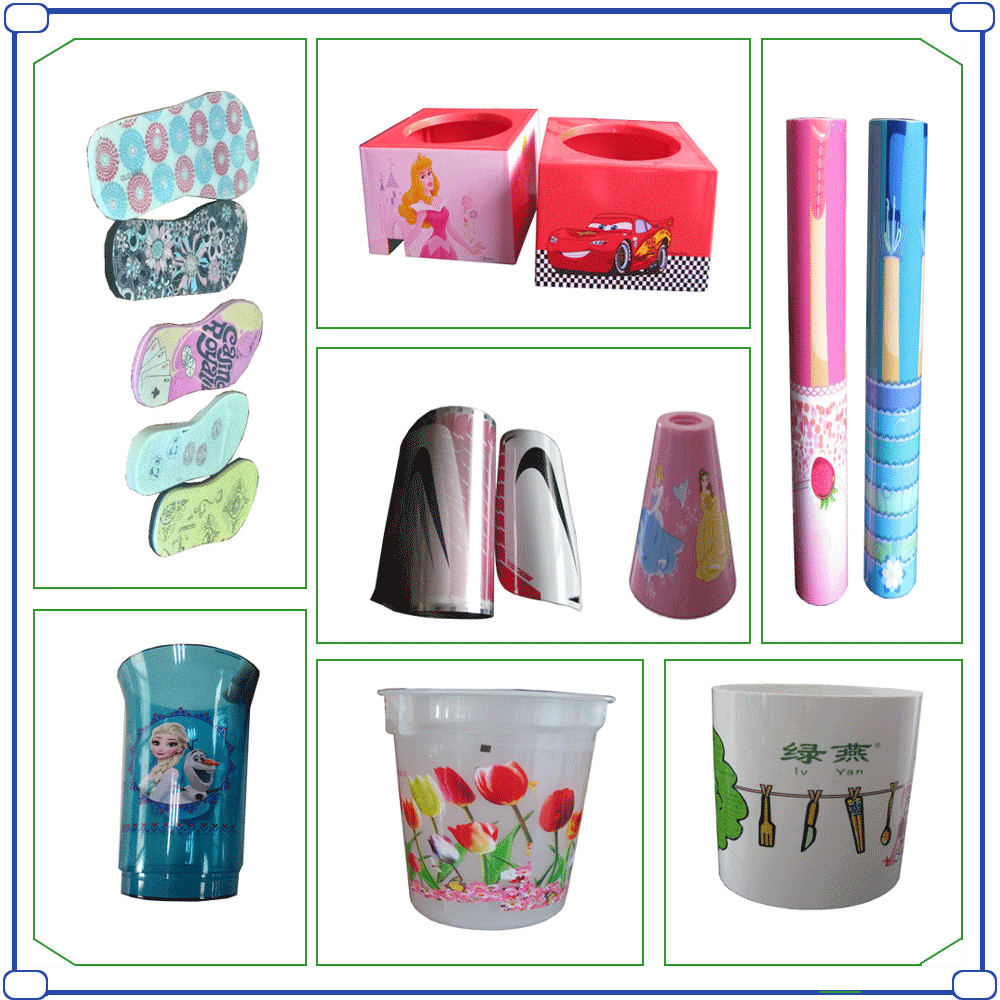Heat transfer technicals
Plastic cups can obtain very exquisite patterns by heat transfer process. For cups with not too large taper, ordinary surface heat transfer machine is enough. The so-called ordinary heat transfer machine is that the heat transfer film is conveyed in parallel. . But when the taper of the cup is large, because the big end of the cup needs to turn over a larger arc length, and the small end of the cup needs to turn over a smaller arc length, the thermal transfer film will wrinkle. To solve this problem, A special taper heat transfer machine came into being. The taper heat transfer machine installs the heat transfer film on a device that can transport the heat transfer film in a fan shape according to the taper of the cup, so that the big end and small end of the cup are in contact with the heat transfer film. The big end and the small end of the contact, complete the transfer. This way, the pattern of the tapered cups will be very precise.
Thermal transfer plastic cups and cup silk screen printing, cup bronzing and other special processes together constitute a complete system of cup printing.

The heat transfer printing on the fabric is very different from the heat transfer printing on plastic products. In order to distinguish them, we call the heat transfer printing on the cloth sublimation transfer printing, and the heat transfer printing on the plastic products is called thermal transfer. print.
The principle of sublimation transfer printing is to use heat and pressure to transfer the graphic layer on the sublimation paper to the surface of the fabric. Since it involves the sublimation process, it is called the sublimation transfer process.
1) Dye sublimation transfer machine
Sublimation transfer machines usually use a large-diameter heatable steel roller as a source of pressure and heat. During the transfer process, the sublimation paper and fabric are in close contact and enter the gap between the felt and the roller to achieve transfer.
2) Padding
In order to achieve uniform and stable pressure, sublimation transfer machines usually use heat-resistant blankets as pads to compensate for pressure on paper and cloth. The blanket is the most important consumable for the sublimation transfer machine, requiring careful maintenance and regular replacement.
3) Sublimation paper
Before transfer printing, use the printer to print the graphics and texts to be transferred onto the sublimation paper, and the cloth and sublimation paper will enter the middle of the roller and the felt synchronously to complete the embossing. Sublimation paper is also the most important consumable, and choosing sublimation paper with good deinking property is an important factor to achieve perfect transfer printing.
The sublimation transfer printing of fabrics is directly related to people's dressing and traveling, so it is used in a large amount and has a huge market in the world.

The thermal transfer process is to print the pattern that needs to be decorated with a concave printing machine on the OPP or PET film, and then transfer the pattern on the film to the surface of the product with the thermal and pressure -stress action.
The advantages of the thermal transfer process we preach are that there is no need to make a version, which can complete the exquisite seal at one time to achieve a order -oriented printing. It cannot be regarded as the advantage of the thermal transfer process.
The large diameter plastic barrel used the heat transfer technology very early, and the thermal transfer machine has become increasingly mature in the field of transfer of large plastic buckets. Our requirements for thermal transfer machine are to transfer it to the thermal transfer film of the plastic barrel. It is long enough, and the width of the junction area is about 10mm.
The initial heat transfer machine did not automatically send the membrane mechanism, but placed the plastic barrel on the workbench of the thermal transfer machine to complete the transfer. However, this method is very slow and the effect of the transfer is not good. Therefore, the current thermal transfer machine basically uses a servo -controlled thermal transfer film conveying mechanism.
We know that the large plastic bucket has a certain taper, and the rubber roller has a line contact with the plastic barrel in the rotation process. The angle speed of each contact point is the same and the line speed is different. The phenomenon of wrinkles must occur, and the automatic transfer process is actually difficult to complete.
In order to accurately control the conveying status of each point at each point of the thermal conversion film and the plastic bucket contact line, it is very important to develop a set of adjustment of the adjustment of the heat transfer film transportation.
The existence of plastic bucket taper has led to a fan -shaped area where the plastic barrel has transformed in the rotation process. It forms a fan -shaped outer fan at a large end and a fan -shaped inner fan surface. Engineers can design a set of orbits that are rotated by the fan -shaped expansion surface to control the conveyor of the thermal transfer film on the machine. The large -end parameters can be adjusted, the parameters of the small end can be adjusted. The purpose of hot transfers.

The most prominent feature of thermal transfer printing is to transfer the rich colors printed by the gravure printing machine to the surface of plastic products, which makes up for the monotonous and dull defects of pad printing, silk screen printing, bronzing and other special printing methods. Heat transfer printing is suitable for products in the following shapes:
1) Cylinder
The unfolded surface of the cylinder is rectangular, and the rotation of the product driven by the fixture can realize exquisite transfer printing on the surface of the cylinder product.
2) Ellipse cylinder
The unfolded surface of the elliptical cylinder is also rectangular, but the generatrix of the rotation process is floating up and down. It is necessary to make a heat transfer machine with the rubber roller floating up and down or the jig floating up and down to transfer.
3) Cone
The expanded surface of the cone is fan-shaped. In theory, all cones can be transferred, but in fact, when the cone is too large, even if the taper heat transfer machine is used, the wrinkling of the heat transfer film is unavoidable. Therefore, thermal transfer is only suitable for cones with a taper below 7 degrees. If the transfer size of the cone is not large, it can also be transferred with a standard curved surface transfer machine
4) Plane
Flat products are suitable for all printing methods, of course, heat transfer printing is no exception, flat products are product shapes that must be faced by heat transfer printing processes. From the point of view of machine manufacturing, planar products are the simplest, but some products have many sides, such as four sides, six sides, if each side needs to be transferred, you can make a fixture that can perform multiple reversals, Achieve multi-sided printing results.
5) similar arc surface
Some products are approximately flat and can be transferred using a so-called profiling heat transfer machine. During the transfer process, ensure that the rubber roller and the product are in close contact.






